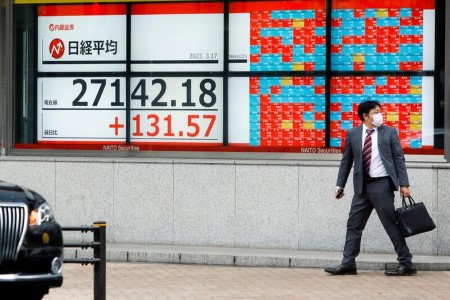




Philippines Trade Update: Trade trajectories trend along
 DOWNLOAD
DOWNLOAD

Policy Rate Updates: Double cut finale
 DOWNLOAD
DOWNLOAD

Monthly Economic Update: One for the road
 DOWNLOAD
DOWNLOAD


Japanese shares end higher as worries over banking crisis ease

SINGAPORE, March 17 (Reuters) – Japan’s Nikkei share average ended higher on Friday, led by banking and electronics stocks, as easing worries over crisis at US private lender Silicon Valley Bank SIVB.O and Swiss bank Credit Suisse Group CSGN.S propped sentiment.
The Nikkei closed 1.2% higher at 27,333.79, while the broader Topix ended up 1.15% at 1,959.42.
The Nikkei index, however, ended lower for the week, amid a brewing banking crisis that sent bond yields plunging, while market participants sharply lowered expectations of future interest rate hikes in Western economies.
The stronger closings for the day follow a risk rally in the broader Asian markets and Wall Street overnight, which are set to spill over to European equities.
“The rescue package from U.S banks reassured the public’s confidence in the banking system, causing a relief rally,” CMC Markets analyst Tina Teng said.
“The recent event suggests that central banks are most likely to temper their rate hikes, which could be a fundamental change to stock markets.”
Investors are now on awaiting any developments as policy tightening by central banks could persist. The European Central Bank on Thursday raised rates by half a percentage point.
The Japanese yen pulled back from its one-month high to 133.78 per dollar.
Electronics giant Sony Group Corp. and financial institution Mizuho Financial Group Inc 8411.T, up 3.52% and 1.96%, respectively, were among the top gainers on the Nikkei.
Construction firm Taisei Corp., down 8.13%, was the biggest decliner, followed by Nippon Sheet Glass Co Ltd. that fell 2.41%.
Of the 225 Nikkei constituents, 147 rose, 74 fell and four remained unchanged.
The biggest percentage gainers in the Topix were entertainment company Sanrio Co Ltd. and education firm Business Breakthrough Inc., rising 16.73% and 19.46%, respectively.
Social shopping firm Enigmo Inc. and pub chain operator Hub Co Ltd. were the biggest decliners, down 12.58% and 9.39%, respectively.
(Reporting by Yantoultra Ngui; Additional reporting by Ankur Banerjee)
This article originally appeared on reuters.com





 By Reuters
By Reuters